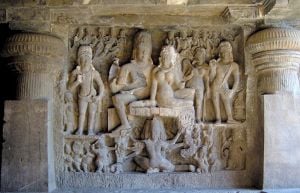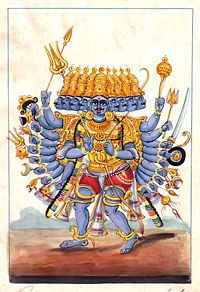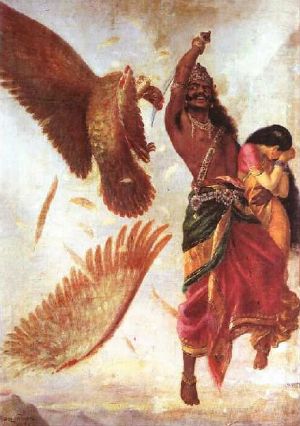Difference between revisions of "Ravana" - New World Encyclopedia
m (intro) |
m (intro) |
||
| Line 2: | Line 2: | ||
[[Image:Ravana.jpg|thumb|200px| A depiction of Ravana, Hindu [[rakshasa]] [[Monarch|King]] of Lanka]] | [[Image:Ravana.jpg|thumb|200px| A depiction of Ravana, Hindu [[rakshasa]] [[Monarch|King]] of Lanka]] | ||
| − | + | '''Ravana''' ([[Devanagari]]: रावण) is the principal antagonist of [[Rama]] in the famous [[Hinduism|Hindu]] epic, the ''[[Ramayana]]''. In the epic, occuring many thousands of years ago, Ravana is the king of [[Sri Lanka|Lanka]], as well as overlord of the [[Rakshasa]]s or demons. By kidknapping [[Sita]], the wife of Rama, he sets in motion a chain of events which culminate in a cataclysmic battle between he and Rama. | |
== Mythology == | == Mythology == | ||
Revision as of 23:57, 9 August 2007
Ravana (Devanagari: रावण) is the principal antagonist of Rama in the famous Hindu epic, the Ramayana. In the epic, occuring many thousands of years ago, Ravana is the king of Lanka, as well as overlord of the Rakshasas or demons. By kidknapping Sita, the wife of Rama, he sets in motion a chain of events which culminate in a cataclysmic battle between he and Rama.
Mythology
Early Life
Ravana was born to the Brahmin sage known as Vishrava. His mother was the Daitya princess Kaikesi. Kaikesi's father, Sumali, king of the Daityas, wished her to marry the most powerful being in the mortal world, so as to produce an exceptional heir. Sumali rejected the kings of the world, as they were less powerful than him. Kaikesi searched among the sages, and finally chose Vishrava. Vishrava warned her that as she approached him at an inappropriate time, their children would tend towards evil, but accepted her nevertheless. As such, Ravana was partly Daitya, and partly Brahmin. Ravana was the eldest of Kaikesi's children, given the name Dashanana/Dasagriva at birth since he was born with ten heads (Some say the ten heads were due to the reflections of a crystal necklace gifted to him by his father at the time of his birth or he had the mental strength of 10 people). His brothers were Vibhishana and Kumbhakarna. Through his mother, he was related to the daityas Maricha and Subahu. Kaikesi also produced a daughter, meenakshi (meaning: girl with fish like eyes), although later she was dubbed the infamous Shoorpanakha (the one with sharp fingernails). Nakha means nails in sanskrit.
His father Vishrava noted that while Ravana was aggressive and arrogant in his youth, he was also an exemplary scholar. Under Vishrava's tutelage, Ravana mastered the Vedas and the holy books and also the arts and ways of Kshatriyas. Sumali, his grandfather, worked hard in secret to ensure that he retained the ethics of the Daityas. Ravana was also devoted. Following his initial training, Ravana performed an intense penance to Brahma, lasting several thousand years. Pleased with his austere penance Brahma offered him a boon. Ravana asked for immortality, which Brahma refused. Ravana then asked for absolute invulnerability and supremacy before gods and heavenly spirits, other demons, serpents and wild beasts. Contemptuous of mortal men, he did not ask for protection from them. Brahma granted him these boons, and additionally great strength by way of knowledge of divine weapons and sorcery.
Conquests
After winning these boons, Ravana sought out his grandfather, Sumali, and assumed leadership over his army. He then set his sights on Lanka, an idyllic island society, created by the celestial architect Vishwakarma for Kubera, the treasurer of the Gods. Kubera was also the son of Vishrava, and had generously shared all that he owned with Kaikesi's children. Ravana however, demanded Lanka in it's entirety from him, threatening to take it by force. Vishrava advised Kubera to give it up to him, as Ravana was now undefeatable. Although Ravana took Lanka by force to begin with, he was nevertheless regarded as a benevolent and effective ruler. Lanka flourished under his rule - it is said the poorest of houses had vessels of gold to eat and drink off, and hunger was unknown in the kingdom.

Following his conquest of Lanka, Ravana encountered Lord Shiva at his abode upon Mount Kailash. Unknowingly, Ravana attempted to uproot and move the mountain on a whim. Shiva, annoyed by Ravana's arrogance, pressed his little toe on Kailash, pinning him firmly (and painfully) under the same. Once Ravana was informed of whom he had crossed, he became penitent. He composed and sang songs praising Shiva, and is said to have done so for several years, till Shiva released him from his bondage. Pleased with his bravery and devotion, Shiva granted him further strength, culminating in his gifting him the Chandrahas (Moon-blade), an immensely powerful sword. Ravana in turn became a lifelong devotee of Lord Shiva. Ravana is known for his dance worship Shiva Tandava Stotra (a form of Stuti) to Lord Shiva.It is during this incident that he officially acquired the name 'Ravana', meaning "(He) Of the terrifying roar", given to him by Shiva - the earth is said to have quaked at Ravana's cry of pain when the mountain was pinned on him
Ravana's abilities were by now truly awe-inspiring, and so he set out confidently on a series of campaigns upon which he conquered human and celestial beings alike. Conquering the netherworld completely, he left his son Ahiravana as king. He became supreme overlord of all asuras in the three worlds, making an alliance with the Nivatakavachas and Kalakeyas (two clans he was unable to subdue). Conquering several kingdoms of the human world, he performed the suitable sacrifices and was crowned Emperor. Kubera at one point chastised Ravana for his cruelty and greed. Proceeding to the heavens, Ravana fought and defeated the devas, singling out his brother for particular humiliation. By force he gained command over the gods, celestials and the serpent races. By the time of the Ramayana, set several hundred years later, Ravana is shown as dominating all human and divine races, to the extent that he can command the Sun as to his rising and setting.
Wives and Womanizing
Ravana was known for his virility as well and his aggressive conquests of women. Ravana had several wives, foremost of whom was Mandodari - daughter of Mayasura and an apsara named Hema, who often compared to Sita for her wisdom and grace as well as beauty and chastity. His wives bore him seven sons: Indrajit, Prahasta, Atikaya, Akshayakumara, Devantaka, Narantaka, Trishira. In addition to his wives, Ravana maintained a harem of incredible size, populated with women whom he captured in his many conquests, many of them accepted and lived happily in his harem for his great manhood, power and knowledge in every direction. Ravana forced himself upon any woman who rejected his advances.
It was just this type of rambunctious sexuality that would drive the central conflict of the Ramayana. The first was the molestation of the sage-woman Vedavati. Vedavati had been performing penance with the intention of winning Lord Vishnu for a husband. Ravana met her at her hermitage, her beauty enhanced by the austerities she had performed. She, however, rejected his advances. Ravana proceeded to forcibly take her, upon which she prophesied that she would return to the mortal world as the cause of his death. She then created a pyre and let herself be consumed in it. She was re-born as Sita, thus becoming Vishnu's (as Rama) wife, and the cause of Ravana's defeat. The second was his encounter with the apsara Rambha, upon whom he forced himself. Rambha was betrothed to Kubera's son, but her plea that she was like a daughter to him did not deter Ravana. Angered at this, Kubera's son cursed Ravana, stating that his ten heads would fall off his head if he forced himself upon any woman from that point. This curse is said to have protected Sita's chastity while she was Ravana's captive for nearly a year.
These acts of sexual impropriety culminated Ravana's decision to kidnap Sita, an act to which all his previous transgressions pale in comparison. After Rama was banished to the jungle, Sita chose to accompany him, asserting that it is an essential duty of a wife to be at her husband's side at all times. One day when Rama had gone away from his ashram in the forest, Ravana crept into the ashram where Sita sits vulnerable and kidnaps her. The discovery of Sita's absence prompts Rama and Lakshmana to partake on a hazardous search to find her again. Sita remains under the captivity of Ravana for one year, all the while protecting her chastity at all costs, completely unwavering in her resolve despite Ravana's courting, cajoling and assorted threats.
Defeat at the Hands of Rama
After overcoming numerous arduous challenges, Rama crosses the ocean and enters into Lanka in order to confront Ravana, rescue his wife, and bring the narrative of the Ramayana to a climax. Rama offers Ravana a final chance to make peace, suggesting that he immediately return Sita and apologize to both he and his wife. As a minister and brother of Ravana, Vibhishana advised Ravana to return Kidnapped Sita and uphold Dharma. Ravana rejected these attempts to avoid battle, going so far as to banish his brother from his kingdom. Vibhishana immediataly sought protection from Sri Rama, which was granted without hesitation, allowing him to become a great devotee of Sri Rama; Rama and the Vanaras are also assisted by Vibheeshana, whose knowledge of Ravana's proficiency with black magic and mystical weapons allows Rama to gain a strategic advantage in the ensuing battle. In the battlefield, Rama slays the most powerful rakshasa commanders, along with hundreds of thousands of rakshasa soldiers, aided by the Vanaras or monkey-men who fight alongside him. In an attempt to create divisions in Rama's ranks, Ravana tries to convince the Vanaras that Rama considered them to be no more than lowly, expendable animals. However, the faithful monkeys angrily dismiss Ravana's claims and continue to fight.
With his rakshasas neutralized, Ravana is forced to square off one on one with Rama. In their first battle, Ravana is severly injured, and his chariot and weapons are destroyed. Due to this injury, Rama allows Ravana to live and return to fight another day. In their next meeting, Ravana unleashes the full extent of his his magical abilities while making full use of the boons given to him by Siva and Brahma. After a drawn-out battle, Rama successfully decapitates Ravana's central head, and a revolting head promptly arises in its place. Rama goes on to decapitate this head, only to find yet another growing in its place, all because of a vessel of amrit, the nectar of immortality, which he had stored in his stomach. This cycle of decapitation and regeneration continues on until twilight, when Ravana's magical powers. At this point, Vibheeshana informs Rama of why Ravana's heads continued to regenerate. Rama then worships Lord Aditya, the Sun, with the famous Aditya Hridayam prayer and then invokes the brahmastra, a weapon of mass destruction. Rama fires the great arrow into Ravana's midsection and destroys the cache of amrit, bringing about the demon king's demise, and allowing Sita to be freed.
Depiction
Ravana is depicted in art with up to ten heads, signifying absolute arrogance and pride. His ten heads earned him the names "Dashamukha" (दशमुख, The ten-faced), "Dashagriva" (दशग्रीव, The ten-necked) and "Dashakantha" (दशकण्ठ, Ten Throats). He also had twenty hands, signifying greed and never-ending want. Ravana is a popular subject of folk art throughout India and Sri Lanka, as well as many other regions to which the Ramayana has spread.
Legacy
Ravana's malevolent spirit is not exhausted with his death at the climax of Ramayana; rather, his legacy of evil is reiterated and revisited theologically in many later Hindu texts. In the Bhagavata Purana, for instance, Ravana and his brother, Kumbakarna were said to be reincarnations of Jaya and Vijaya, gatekeepers at Vaikuntha, the abode of Vishnu and were cursed to be born in Earth for their insolence. These gatekeepers refused entry to the Sanatha Kumara monks, who, because of their powers and austerity appeared as young children. For their insolence, the monks cursed them to be expelled from Vaikunta and to be born in Earth. The all-merciful Vishnu agreed that they should be punished but agreed to mitigate their curse. He asked them whether they would want to be undergo seven births as devotees of Vishnu or three births as enemies of the Lord. Since they wanted to get back as soon as possible, they agreed to be born in three births as enemies of God. In the first birth, Jaya and Vijaya were born as Hiranyakashipu and Hiranyaksha. Vishnu incarnated as Varaha and Narasimha and killed them both. In the Treta Yuga they were born as Ravana and Kumbhakarna and were killed by Rama. Then in Dwapara yuga, and in their final birth, Jaya and Vijaya they were born as Shishupala and Dantavakra and killed by Sri Krishna. After the end of three births, they returned to Vaikunta.
Despite his villanous behaviour, Ravana is still sometime acknowledged as a great and noble man due to his venerable character. He is considered to have possessed several important virtues, the foremost being his knowledge of the sacred books, medicines and sorcery. Ravana was also a great devotee of Shiva, and is supposed to have composed the Shiva Tandava Stotra, according to legend. Further, his skills as a leader are acknowledged; although Ravana took Lanka by force to begin with, he was nevertheless regarded as a benevolent and effective ruler, bringing times of great prosper to the island. His successes notwithstanding, Ravana was a tragic figure who engendered his own demise with his unfettered sexual desire and his imperious militarism. As could be expected, he continues to endure as the archetypal villain in the Hindu tradition, and is still identified as such by Hindus today.
Credits
New World Encyclopedia writers and editors rewrote and completed the Wikipedia article in accordance with New World Encyclopedia standards. This article abides by terms of the Creative Commons CC-by-sa 3.0 License (CC-by-sa), which may be used and disseminated with proper attribution. Credit is due under the terms of this license that can reference both the New World Encyclopedia contributors and the selfless volunteer contributors of the Wikimedia Foundation. To cite this article click here for a list of acceptable citing formats.The history of earlier contributions by wikipedians is accessible to researchers here:
The history of this article since it was imported to New World Encyclopedia:
Note: Some restrictions may apply to use of individual images which are separately licensed.

